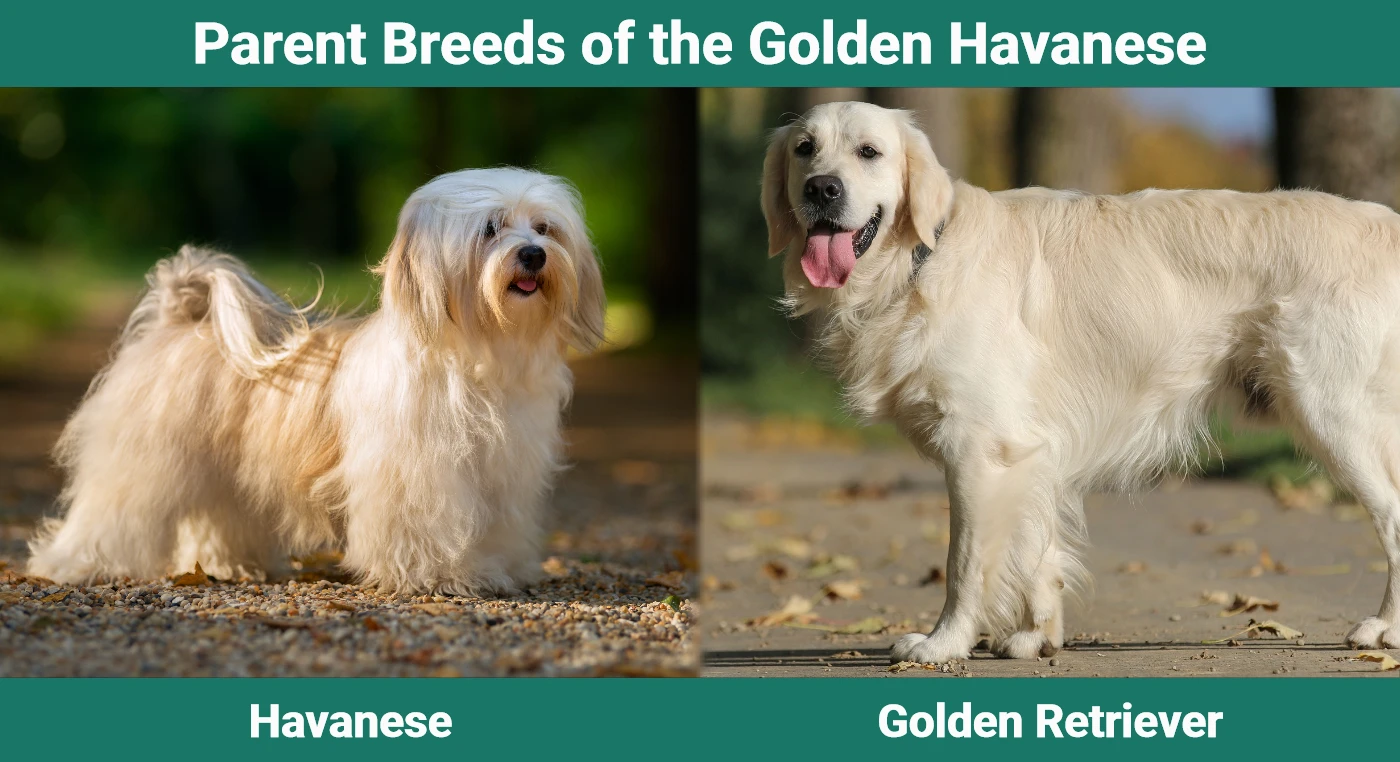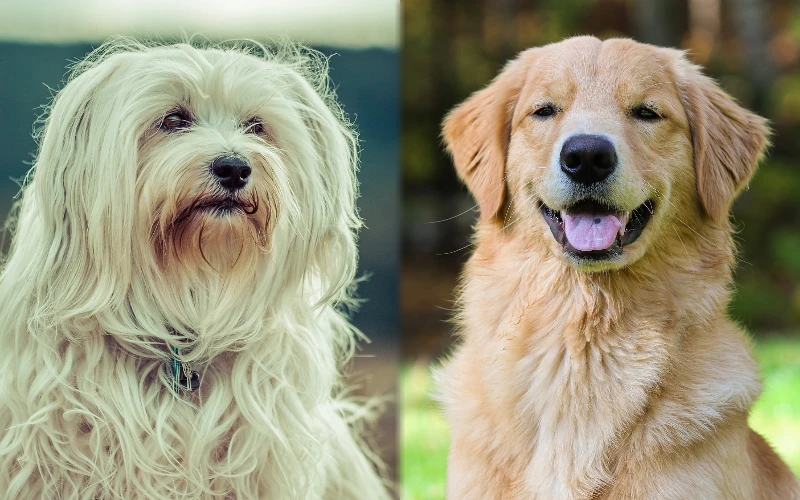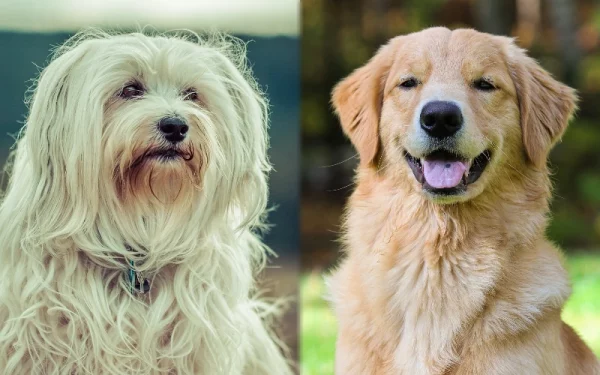Click Below to Skip Ahead
The Golden Havanese is a unique mix that you may have a hard time finding unless. Most intentional designer dogs involve pups about the same size. This one includes the Havanese, which gets up to 11.5 inches high and up to 13 pounds. On the other hand, the Golden Retriever is a large dog, getting up to 24 inches tall and 75 pounds. However, there is a lot more than just their size that you need to know about.
Breed Overview
Height:
9–13 inches
Weight:
8–14 pounds
Lifespan:
12–15 years
Colors:
Fawn, gold, tan
Suitable for:
Active families looking for a small, friendly dog
Temperament:
Intelligent, kid-friendly, playful
It might be safe to say that the mix of this breed is best when the female is the Golden Retriever instead of vice versa. Those crosses can be dangerous for the female Havanese without vet involvement during the pregnancy and birth of the puppies. Nevertheless, the result is an adorable pup that can bring together some of each parent breed’s most endearing traits, with friendliness topping the list.
Golden Havanese Puppies
The scarcity of the Golden Havanese leads to our round-up of things to know before getting a puppy. Poodles have been popular breeds in many designer dogs. Their intelligence and lack of shedding are potent incentives for creating the perfect match. The same applies to the Golden Retriever and the Havanese. Both are intelligent dogs that are easy to train.
However, they do tend to shed. The Golden Retriever sheds to some degree year-round between its two big seasonal occurrences in spring and fall. The Havanese is a minimal-shedding dog. Nevertheless, it all depends on genetics, as variability exists with both parent breeds. Testing for this trait exists, though. Regardless, even a purebred Havanese requires some grooming.
Another factor is the popularity of the respective breeds. The American Kennel Club (AKC) has recognized the Golden Retriever since 1925. It currently stands third in the most popular dogs. The Havanese is a new kid on the block, with official recognition in 1996. Nonetheless, it is the 25th most popular breed. This information can also affect the availability of the Golden Havanese.
Golden Havanese Puppies
It’s difficult to pinpoint a price for a Golden Havanese puppy because of their rarity. On the one hand, you have two popular breeds that can command high prices as purebred dogs, especially if they come from a good bloodline. On the other hand, there are the health risks of this cross that may make a breeder reluctant to pursue it. If so, it will probably add considerably to their costs as sellers.
However, pet ownership is a commitment and financial responsibility. The first year is usually the most expensive because of the extra veterinary care for puppies. Your costs may run higher because of the unique nature of this mix. Your vet may recommend spaying or neutering your pup because of the health risks in subsequent generations.

Temperament & Intelligence of the Golden Havanese
The Golden Havanese comes from good stock. The Golden Retriever is an intelligent animal, nurtured from their role as a hunting companion. A dog must be alert and act decisively at this job. Enthusiasts have selectively bred this pup to bring out this trait.
The Havanese lived a life of luxury during the breed’s history. This close connection with humans helped this pup bond with their companions and learn their behavior and body language. It also instilled an eagerness to please in the Havanese that profoundly affected their personality.
Are These Dogs Good for Families?
Both parent breeds couldn’t be a better choice for families. They love everybody! That’s particularly true if you socialize your puppy early and introduce them to new people and experiences. If your Golden Havanese is on the large side, we suggest supervising playtime with young children. The Havanese is more laid back but is still as playful as they come.
Does This Breed Get Along With Other Pets?
The Golden Havanese will likely have a moderate prey drive, something they would inherit from both parent breeds. That may make a puppy more likely to chase the family cat. Again, early socialization is critical if you have other pets in the household. Supervise their time together, particularly if your kitty still has their claws.
Things to Know When Owning a Golden Havanese
Getting a relatively new and rare mixed breed like the Golden Havanese comes with a lot of unknowns. However, the environment in which a dog is raised significantly impacts a dog’s behavior. Early socialization and daily walks can go a long way toward perfecting your pet’s canine manners. It’s worth mentioning that both parent breeds are sensitive to harsh words and intolerant of being alone.
The former comes into play with training. The latter involves the animal’s quality of life and suitability for the household. The Golden Havanese is not a pet to be left alone for hours on end. This dog wants to be a part of the action. That’s what makes them such a good choice for families. However, there are other things you should know to ensure this pup is a good fit for your lifestyle.
Food & Diet Requirements
If your Golden Havanese is on the small side, ensuring your pet eats at every meal is critical. Puppies should get fed three to four times daily. This will support growth and development. We suggest asking to see your pup’s littermates and the parents when you buy your dog to get an idea of their adult size. It makes a difference in the food you’ll give your pet.
Small breeds mature quicker than large ones. Thus, their respective diets vary with the unique nutritional needs of the dogs. We suggest discussing your choice with your vet, given the size range of this mix. Once your Golden Havanese reaches adulthood, you can reduce the feeding schedule to two times daily.
Exercise
The Golden Retriever is the more active of the two parent breeds. Nevertheless, we recommend daily walks for physical activity and mental stimulation. That latter is particularly necessary for intelligent dogs. This enrichment will make them better pets. Both parent breeds are friendly toward other dogs and people, making your task easier.
Training
The Golden Havanese is easy to train. You should use positive reinforcement and avoid scolding your pet. This pup is an excellent choice for first-time dog owners, provided you are consistent with the lessons. The Golden Retriever is sometimes nippy. Curbing this unwanted behavior will be a necessary part of your pooch’s training. Luckily, neither parent breed is particularly vocal.
Grooming ✂️
The amount of time you’ll spend grooming depends on which parent is dominant. The Golden Retriever has a thick double coat that will require weekly brushing. The Havanese has a silky coat with fine hairs, a trait resulting from selective breeding. Many pet owners keep these pups in a puppy coat to prevent mats.
Health and Conditions
Every breed has some issues that you should know about upfront. Reputable sellers screen their dogs for the most common conditions. We strongly urge you to buy only from a breeder conducting these screenings. You should also ask about a health guarantee and what it covers.
- Deafness
- Eye disorders
- Ear infections
- Hip and elbow dysplasia
- Luxating patella
- Cardiac disease
Male vs. Female
The sex differences between male and female Golden Retrievers are noticeable compared to the Havanese. The dominant part will determine which is present with your puppy. Otherwise, both sexes will make delightful pets. We suggest discussing neutering or spaying with your vet. Research has shown a greater risk of specific cancers in neutered Golden Retrievers that may affect your decision.
There’s also the question of behavior issues. Some intact male dogs are more aggressive than others. They also show a greater propensity to bite. The question of neutering or spaying dogs is not as clear-cut as it once was. However, don’t discount the role you have in molding your pup’s personality.
3 Little-Known Facts About the Golden Havanese
1. Either Spaniards or Italian Sea Merchants Brought the Havanese to Cuba
Unlike many dogs, the Havanese didn’t have a job. Its role was to look cute and be friendly. Travelers to the New World brought these lovable pups on their voyages, where they found their home in Cuba. The country’s capital provided the breed’s name.
2. The Golden Retriever’s Origin Is Noble and Scottish
Enthusiasts credit Dudley Marjoribanks, or the first Lord Tweedmouth as the individual responsible for developing and refining the breed at his Scottish Highland estate, Guisachan House.
3. The Golden Retriever Had Presidential Connections
President Gerald Ford received a Golden Retriever puppy named Liberty. The rest, as they say, is history. She was the darling of the nation and spurred the breed’s popularity with her own litter of eight puppies.
Conclusion
The Golden Havanese is a rare cross that can be difficult to find. Biology and the various characteristics of the parent breeds play a significant role. This mixed breed brings other challenges to the table. Therefore, we suggest researching your purchase and screening sellers before bringing home a puppy.
The Golden Havanese requires an active, loving family that will shower this pup with all the attention they desire. If you have the time and are willing to accept the responsibility, this pooch may have a lot to offer you and your family.
Related Reads:
- Golden Sammy (Samoyed Golden Retriever Mix): Pictures, Care, Info, & More
- Goldendale (Airedale & Golden Retriever Mix): Care, Pictures, Info & More
Featured Image Credit to: Left – buchsammy, Pixabay | Right – Shayna Douglas, Unsplash











